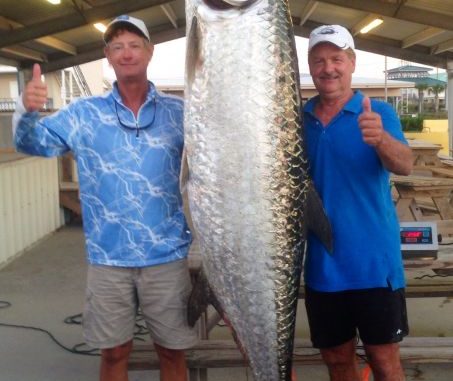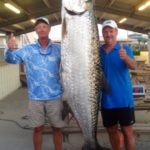
Louisiana’s tarpon fishery is much different than it used to be less than 100 years ago – but why?
Listen to this:
“When an angler sets a hook in a tarpon, there is an explosion. There’s no delayed action fuse in this fish. The water erupts and a platinum-silver streak shears the surface with the force of a depth charge exploding. The fish emerges with head thrashing and its gleaming body sparkling in the sunlight, lashing right and left in a wild attempt to free itself. If it doesn’t throw the hook on that first jump, time and again this sky-walking fish will burst from the surface in high, broad, twisting, tail-walking jumps making a bid for freedom.”
Wow!
Those words were written in the 1970s by McFadden Duffy, outdoor editor for the New Orleans Times Picayune newspaper. McDuff, as he was known to his friends, was also a frequent contributor to the Louisiana Department of Wildlife and Fisheries’ Louisiana Conservationist magazine, where the words above appeared.
He liked tarpon fishing — actually, he loved tarpon fishing. And he had a lot of company. Hundreds, maybe thousands of fishermen chased the silver king across the whole of Louisiana’s coast.
But things have changed a lot.
Current state record holder David Prevost estimates that there are now only 20 serious boats targeting tarpon, with maybe another 20 boats casually doing so.
Why?
Are other fish more attractive now?
Maybe it’s the edibility factor. Tuna are vicious fighters. Tuna are common. Tuna are great table fare. At the height of the Louisiana tarpon fishery, tuna fishing as we know it now didn’t exist. Now it’s booming.
Some fishermen certainly rolled backward inshore and joined the ranks of those obsessed with trophy speckled trout fishing or sight-casting for redfish. In the 1950s to the early 70s, when tarpon fishing was booming, speckled trout were those fish we used to catch “by the box,” and most of them were “cigars” (9- to 12-inch fish) or “schoolies” (12 to 14 inches).
Redfish then were rated barely better than trash fish.
Are there fewer tarpon?
Maybe there are less tarpon out there to catch. Forrest V. Durand, assistant biologist with the Louisiana Bureau of Research and Statistics, wrote this in the July 1933 issue of the Louisiana Conservation Review.
“The writer, from the deck of a boat anchored in Barataria Pass, has observed the water churned into a commotion by these fish as far as it was possible to see, up Barataria Bay on one side and the same distance out into the Gulf on the other.”
William Dailey and Andre’ Landry Jr., Texas A & M University biologists studying the Louisiana tarpon fishery, have called the 1960s “the Golden Era.” Some numbers bear that out, in spite of 89 tarpon being taken at the Southwest Pass Tarpon Rodeo in 1947.
The Abbeville Kiwanis Tarpon Rodeo weighed in 110 tarpon in 1966. The Golden Meadow Tarpon Rodeo had 45 fish entered in 1967.
Even landings at the International Grand Isle Tarpon Rodeo peaked at that time, with a record 48 tarpon in 1966. Over 30 tarpon have been landed four times in rodeo history, and three of those were in the 60s: 1962, 1965 and 1968.
Of course, the A & M biologists noted that in the 1960s, tarpon anglers at the big rodeo averaged about 500 in number, compared to about 100 in 2007.
And the catch-and-release ethic is strong today. Tarpon that have no chance of winning rodeos are often tagged and released. But still; today’s “catches” are not on par with yesteryear’s “landings.”
Are the fish in different places today?
The Texas A&M scientists point out that as recently as the 1970s, Louisiana’s tarpon fishery stretched from April through early November, and was done over a much broader area than today’s July through September fishery, which is concentrated in the area around the mouth of the Mississippi River stretching west to Grand Isle.
Mention was made earlier of the successful tarpon rodeos out of Abbeville, far to the west of Grand Isle. Even further west is the Calcasieu River. A writer in the July 1936 Louisiana Conservation Review marveled at the good tarpon fishing in the river 2 ½ miles upriver from the town of Cameron.
Tarpon were plentiful enough for Lake Charles anglers to found their own Tarpon Club. A 1939 photo shows 15 men and women posed in front of 22 of the slain beasts.
Try catching one there now.
On the extreme other end of the state, Lake Pontchartrain tarpon fishing was hotter than a $2 pistol in the 1930s. The New Orleans backyard lake was the scene of not one, but two annual rodeos. The New Orleans Tarpon Club Rodeo and the Semour Weiss Rodeo both required the tarpon be caught within the city limits of New Orleans.
The No. 1 tarpon in the state’s fish records program for two decades was a 198.5-pounder caught by Oswald Fry in 1951 — a Pontchartrain tarpon.
Schuyler Thibodaux took a 195-pound tarpon (then No. 3 in the records) under the Rigolets bridge in 1973. The big silver king scooped up a croaker Thibodaux was fishing on the bottom.
Do you have any idea how many croakers are soaked on the bottom nowadays by trophy trout fishermen? How many of them ever hook a tarpon now?
The fishery is different in another way
Today’s tarpon fishery is different than the historical fishery in other ways too — not all of them bad. The biggest difference is that tarpon are now definitely much larger than they once were.
Most people date the beginning of the modern Louisiana fishery (although people were catching tarpon before then) to 1928 and the founding of the International Grand Isle Tarpon Rodeo.
From that date until 1973, not a single 200-pound tarpon was recorded, in spite of thousands of active fishermen. Today, with far fewer anglers, every fish in the Top 10 of the state’s fish records program is not just more than 200 pounds, but over 220 pounds.
And it seems to be getting better. Six of the top seven fish were caught since 2011. In 2015, two anglers, David Prevost and Lance “Coon” Schouest Jr., placed fish in the record books. Prevost’s was 246.63 pounds, and Schouest’s was 226.88 pounds.
In spite of the concerns of some biologists over the status of tarpon populations, Dailey and Landry refer to the Louisiana fishery as “relatively robust.”
Next month we will discuss in detail the biological quirks of tarpon — and how to take advantage of them.




